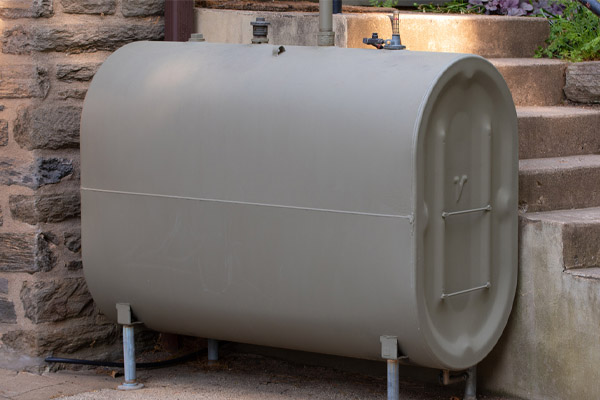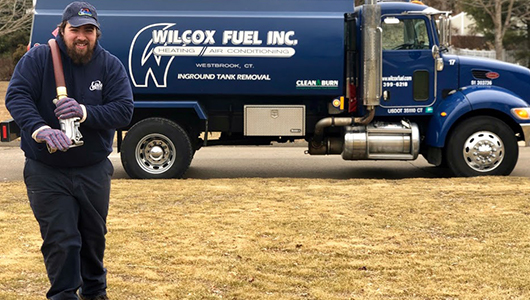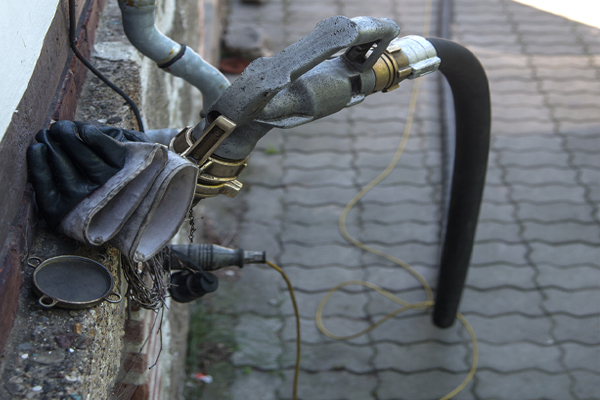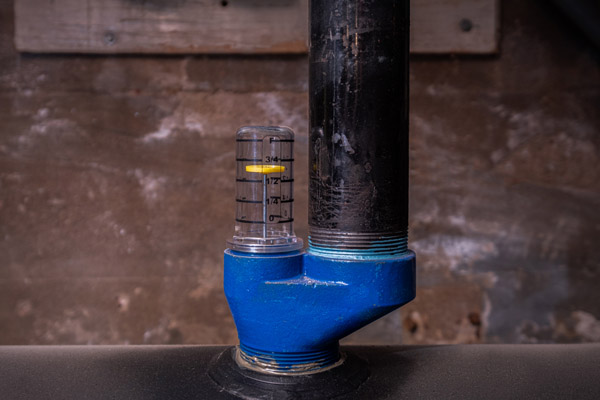Contents
- 1 Reasons To Avoid Running Out of Heating Oil
- 2 How To Prevent Running Out Of Oil
- 3 What You Should Do If You Run Out of Oil
- 4 Call Wilcox Energy For Reliable Heating Oil Deliveries & HVAC Services

If you are part of the millions of homeowners who fuel their furnaces or boiler with propane or home heating oil, one of the biggest troubles you have during winter is checking your tank’s status and scheduling a heating fuel delivery with enough time. Propane or heating oil is vital in our homes. However, many individuals still fail to maintain their heating systems.
For example, oil tanks get lost in the busyness during the winter season. Families often deal with snow issues, the holidays, and family trips at this time, so they forget about the fuel levels in their oil tanks. However, this is when the harshest time of winter starts, so it is crucial that you have a full oil tank. As a result, even highly responsible homeowners run out of fuel during these cold months when they require oil the most.
Failing to monitor your oil levels throughout the year is one potential cause of an empty fuel tank. Other likely reasons are lacking the necessary funds to schedule a delivery, a tank system leak, and stolen fuel.
Regardless of the reason, it can be frustrating to run out of fuel oil or propane. It can also have a significant impact on your health and daily function. The good news is that preventing this issue from happening is not complicated. When you understand the risks associated with running out of fuel, you can ensure that it remains full throughout the year by following simple methods to prevent having an empty fuel tank.
Reasons To Avoid Running Out of Heating Oil
Lacking any preventative measures may not seem like anything major, especially if running out of oil hasn’t happened to you before. However, even responsible homeowners may forget to schedule an oil delivery on time. This is a problem that brings more harm than it seems.
There are several crucial reasons it is necessary to make oil purchases on time. Aside from the inconvenience a cold home and no hot water can bring, here are several other risks you may experience if you do not take preventative measures to ensure your oil tank remains full:
Added Heating Oil Expenses

The most common time homeowners run out of heating oil is during mid- or end of winter. The bad news is that this is also the time when the oil costs are at their highest. Running out of fuel between October and March means you end up paying the highest prices during the heating oil season, which can add up quickly.
Aside from paying more for the oil, an emergency fuel delivery will also cost you a lot more than a regular fill-up. Small fill-ups made across the year cost significantly less than the total cost of emergency service.
Oil Tank Sludge Buildup
You can typically find sludge and debris at the base of oil tanks. They usually don’t damage the heating oil system unless the tank goes empty.
Low oil levels mean the sludge is sucked along with the remaining oil into the supply line. This can cause a clog. If it doesn’t, the sludge goes to a filter that will partially or entirely clog. Blocked fuel lines or filters will lead to reduced efficiency. These issues can also completely shut down your system, and this requires professional assistance to resolve.
Related Article: How Much Heating Oil Will I Use In A Day?
Manual Heating System Reset

At times, resetting the heating oil or propane system after running out of fuel is as easy as pressing a button. However, you require a pilot light reset if the pilot light is off.
According to the law, the pilot light reset should be done by a professional. They will do line bleeding and replace blocked filters, so you will have to spend hundreds more compared to a simple oil fill.
How To Prevent Running Out Of Oil
Many risks are linked to running out of heating oil or propane. Therefore, you shouldn’t wait longer to ensure your home is protected. Manage your home and its heating requirements by taking the necessary preventative steps to ensure you have oil in your heating tank throughout the year.
The general rule approved by the industry is that the tank should always be 1/4 full – at the minimum. However, you don’t have to conduct manual oil tank checks constantly. Many services and technologies are available, and you can use them as preventative measures without the hassle of constant manual monitoring.
Automatic Heating Oil Delivery

You never have to worry about running out of oil again when you sign up for automatic fuel oil delivery services. The best part is that you don’t need to do any work. You do not need to check your tank or calculate when you need to schedule a delivery. Automatic delivery programs allow you to relax as your oil company takes care of everything.
Signing up for automatic delivery means your oil supplier uses a non-invasive technology to track your oil usage. This technology measures your home’s approximate heating oil usage. They utilize simple information regarding your home and family and the calculated HDD or heating degree days. The HDD measures how much energy can heat your home per the outdoor temperature.
Your oil supplier calculates the HDD using the fuel tank size, square footage of your home, and past data on your heating needs. This allows them to accurately determine when your tank will be 1/4 full. They will then contact you directly for the delivery schedule.
Pros of Automatic Oil Delivery
- Most heating oil companies have automatic delivery as their most popular delivery method. It has a high success rate in ensuring your fuel tanks never run out of oil.
- Automatic delivery helps you save the most money out of all preventative methods. Most suppliers reward clients with discounts for signing up for this service, which can add up significantly.
- The system is based on your heating history. The delivery schedules are also based on your home’s unique needs, so you can be sure you only receive what you want and need.
- Non-intrusive calculations mean you do not have to worry about invasive tank monitoring software.
Cons of Automatic Fuel Oil Delivery
- The system doesn’t include unexpected heat increases. If your relatives visit you over the holidays and they will use a lot of water or if you will go on vacation, so you don’t need as much heat as you did, you need to call your oil company to let them know. This way, they can make adjustments to your oil delivery schedule.
- You likely need to commit to a single supplier for a specific period to get the most accurate results. Therefore, you cannot shop around and get different prices throughout the year.
Heating Oil Tank Monitoring Apps & Smart Meters

Smart technology can be found in almost all industries, including wi-fi thermostats, security systems, and cookware. There are technologically advanced alternatives in nearly all parts of our homes. This technology has also been making an impression in the heating oil industry, mainly with the development of smart oil tank meters.
This device lets you instantly track your oil levels, heating costs, and consumption. A sensor attached to your tank sends this data to your smartphone or tablet. The smart software allows you to monitor all these in the comfort of your living room or even from a thousand miles away.
Pros of Smart Meters
- These have alarms built into them, so you are notified in case of oil theft.
- Most smart systems let you know of low oil levels as soon as it happens, so you have time to call your provider.
Cons of Smart Meters
- Smart meters are one of the market’s most expensive oil tracking options. They usually have a $100 or more price tag.
- There have been error reports from smart monitoring software that have had the media’s attention. These rare cases saw up to 50% inaccuracy in electricity-powered monitoring systems.
- Most users still find smart oil monitoring systems accurate, but these occasional inaccuracies should still be checked.
- Most smart meters only alert you, not your oil provider, if you have low oil levels. You still have to contact your supplier immediately so you do not run out of oil.
- Smart meter installation should never be a do-it-yourself project. Call for a professional HVAC technician to help you. The good news is that Wilcox Energy can assist you in installing smart meters during your annual system maintenance appointment. Make sure to call us today if you haven’t booked an oil heating system maintenance yet.
Local Oil Tank Monitors

If you don’t have a smartphone or other device you can connect to a smart meter but still want to check your oil tank levels from the comfort of your home, a local tank monitoring software may be what you are looking for.
They work similarly to smart meters in that they have transmitters that can be attached to your oil tank. This sensor generates a local read-out to a monitor usually plugged into your home.
Pros of Local Tank Monitors
- Most local tank monitors have a quick installation process. The sensor only needs to be placed in the tank, and the monitor plugged into an electrical outlet. This lets non-smartphone users enjoy the advantages a tank read-out system has to offer.
- The system alerts you via the monitor when there is a low oil level, so you do not have to guess when to call your oil supplier.
- Local tank monitors offer more accuracy than standard mechanical float gauges. These devices can even eliminate the need for dipsticks and gauges.
Cons of Local Tank Monitors
- Some monitors can be placed anywhere around your home. However, many require a certain distance from the tank, so you have less freedom compared to smart meters or automatic delivery services. Moreover, some monitors may be battery-powered and can be taken anywhere throughout your house. But most local oil tanks need to be plugged into an electrical outlet, thus, lacking mobility.
- Tank transmitters and monitoring systems can have a price tag that rivals that of smart monitoring software. You may have to spend around $100 on this device.
You still need to call your oil provider for a delivery as it only alerts you and not your oil provider when the tank’s oil level is low.
Oil Tank Alert Systems
Consider using an oil tank alert system if you want a device that notifies you of low oil levels without bells and whistles that come with a smart or local monitoring system. You do not have to pay for extra data or settings with an alert system. The gauge only needs to be installed on the tank so it can start sending alerts to a receiver when there are low oil levels. When you see the receiver flashing or beeping, it means the set amount is reached, and you need to call your oil provider for a delivery.
Pros of Alert Systems
- Alert systems are the ideal option if you are unfamiliar with technology. The receiver is a simple gadget that has no screen or a complex user interface. It alerts you when the oil levels are low without unnecessary additional information.
- The simplicity of alert systems makes them a relatively cheaper option than other tank monitoring software. A unit can be bought for a pretty cheap cost.
- Many receivers are battery-operated, so you can place them almost anywhere throughout your home.
Cons of Alert Systems
- Alarm systems let you know when there are low oil levels, but they do not provide vital information regarding your oil consumption. When you know your seasonal and daily usage, you can determine exactly where it isn’t as efficient and what can be done to reduce your heating expenses. However, alert systems do not track this data.
- This system will not notify your oil supplier of your low oil levels, much like other forms of tank monitoring. You still have to call your oil provider at the last minute to get your tank refilled.
Manually Checking Tank Levels

Your budget may be keeping you from buying a monitoring system or automatic delivery service, but you still need to conduct oil checks, so you do not run out of oil. Experts do not recommend self-monitoring your oil levels, but you can do it as a last resort. To check your tank manually, evaluate the gauge and contact your oil provider when you have low tank levels.
Use a dipstick to determine your tank’s fuel level. Call your oil supplier before it reaches 1/4 full. Ensure that your oil level does not go below the one-quarter mark so that you won’t run out of fuel or cause tank damage.
Pros of Manual Oil Monitoring
- Manual monitoring is the most cost effective choice at the onset. However, you may actually spend more in the long run, especially if you forget to do this task throughout the year.
Cons of Manual Oil Monitoring
- Even highly responsible individuals may forget about their propane or heating oil, especially amidst the bustle of the holiday season. Manual monitoring depends on you going to your tank frequently to check the oil levels. Failing to do this task may lead to needing an emergency fill-up and expensive repairs.
- This monitoring method is the most inconvenient, especially if you have an outdoor tank. Winters can mean harsh weather, and standing outside in the snow and cold winds while checking your oil tank is the last task you want to do.
What You Should Do If You Run Out of Oil
Preventive measures cannot help you if your tank is already empty. You need to take these steps so this problem doesn’t happen again. However, if you already ran out of oil, you must immediately take action to restore your home heating.
Here are several tips on what you can do if your heating oil runs out completely:
- Call your oil provider for an emergency delivery service: This emergency services offer fill-up in less than 24 hours of placing your order.
- Use a substitute for home heating: Use kerosene or diesel fuel to power your heating system until the emergency fill-up services arrive. Use a gasoline-safe canister and fill it with 5 to 10 gallons of fuel oil at a nearby gas station. You can also use a fireplace or other space heaters until more fuel is delivered to your home.
- Insulate your surroundings: Ensure that excess heat remains trapped indoors while you wait for the oil delivery. Tightly close all doors and windows, and use weatherstripping where possible to insulate and reduce heat loss.
Call Wilcox Energy For Reliable Heating Oil Deliveries & HVAC Services

For top-notch service and competitive prices on heating oil deliveries and HVAC services, contact Wilcox Energy as soon as possible.
We offer a broad range of fuel delivery plans and financing options, which allow you to customize your oil deliveries to meet your specific needs. We also deliver Bioheat® heating oil, a blend of ultra-low sulfur heating oil and biodiesel. This liquid renewable fuel makes your home more eco-friendly and your heating system more efficient. It comes to you without any added cost. In addition, we perform heating system repairs and maintenance for the purpose of enhancing the overall efficiency and functionality of all your home heating equipment. Contact Wilcox Energy for all of your residential heating needs.
For more information about our heating oil deliveries or HVAC services, be sure to contact Wilcox Energy. You can click here to contact us or call us at (860) 399-6218. Call now!
